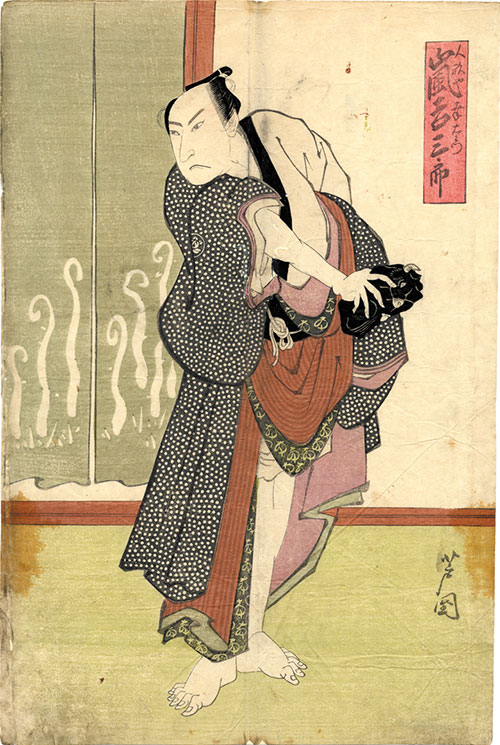Mysterious Osaka ukiyo-e artists
November 28 (Tue), 2023 ‐February 25 (Sun), 2024
This museum exhibits ukiyo-e woodblock prints published in Osaka in the Edo period. Many of the ukiyo-e prints made in Osaka were portraits of kabuki actors unlike those produced in Edo represented by Hokusai and Hiroshige.
Although a study of Osaka ukiyo-e artists has progressed in recent years, there are still many ukiyo-e artists whose background is unknown. It is also said that artists worked part time to draw ukiyo-e. Some artists are confirmed to have drawn only a few ukiyo-e with their career is unknown. Written materials are the keys to the mystery.
In this feature exhibition, we focus on “Ukiyo-e Ruiko”, the most well-known authority of ukiyo-e study and introduce ukiyo-e artists described in it. Ukiyo-e prints on display prove that the artists existed. Enjoy the ukiyo-e prints of lively kabuki actors drawn by Osaka artists.

A doll dealer in ‘Ehon Tengachaya mura’
Drawn by Ashikuni
Performed by Arashi Kichisaburo II
Ukiyo-e Ruiko
Preface of a pocket edition of “Ukiyo-e Ruiko”, edited by Nakata Katsunosuke, says ‘This book is the only authority of a study of ukiyo-e. Anyone who steps into the study definitely should refer to this book. Thus “Ukiyo-e Ruiko” is a basic material when you try to find out the career of the ukiyo-e artist.
The original “Ukiyo-e Ruiko” was compiled by Ota Nambo around 1790 (Kansei 2), so ukiyo-e artists who drew kamigata ukiyo-e from latter half of the Edo period to the beginning of the Meiji era were not in the book. Ukiyo-e Ruiko” was additionally written by Keisai Eisen, aka anonymous old man, and Saito Gesshin and then Nakata Katsunosuke compiled written materials including other documents such as “New expanded version of Ukiyo-e Ruiko” and completed ‘Ukiyo-e Ruiko’ in which names of kamigata ukiyo-e artists were referred to.
Ukiyo-e prints on display here are our collection, drawn by Osaka ukiyo-e artists whose names are in the “Ukiyo-e Ruiko” completed by Nakata Katsunosuke. Descriptions of Osaka ukiyo-e artists are very few even if you include comments from other same kind of materials. The artists introduced here are examples of Osaka ukiyo-e artists in relatively old days.
As the explanation we quote from “Ukiyo-e Ruiko” compiled by Nakata Katsunosuke, Iwanami Bunko, published by Iwanami Shoten, 1941.
芦国 Ashikuni
Ashikuni is said to be a disciple of Suga Ranrinsai. He had many disciples; among them were Ashisato, Ashihiro and Ashiyuki. They formed a school of kamigata ukiyo-e artists.
重信 Shigenobu
A disciple of Hokusai. He got married with Hokusai’s eldest daughter and became Hokusai’s son-in-law but got divorced later. He came to Osaka in 1823 (Bunsei 5) and stayed until 1827 (Bunsei9). In Osaka he drew portraits of kabuki actors and made nerimono (foods made by ground fish meat). His disciple in Osaka was said to include Ryusai Shigeharu, Yanagawa Yukinobu and Kuninao.
重春 Shigeharu
Born in 1802 (Kyowa 2) into a merchant family. He came to Osaka and trained himself to be an ukiyo-e artist and became an apprentice of Takigawa Kunihiro and Yanagawa Shigenobu. While he was an apprentice of Takigawa Kunihiro he named himself Kunishige. He changed his name to Shigeharu around 1827 (Bunsei9). Died in 1852 (Kaei 5).
国員 Kunikazu
He is said to be a member of Toyokuni III school because he called himself Utagawa Kunikazu. He also drew landscape ukiyo-e (his ukiyo-e were included in ‘Naniwa Hyakkei’, One Hundreds Views of Naniwa) as well as Osaka kabuki actors’ portraits at the end of the Edo period.
芳瀧 Yoshitaki
A disciple of Yoshiume, he drew many portraits of Osaka kabuki actors from the end of the Edo period to the beginning of the Meiji era. In the Meiji era he moved to Kyoto and became famous for his painting of beautiful women. He later moved to Sakai. His disciple includes Kawasaki Kyosui. Died in 1911 (Meiji 32).
広信 Hironobu
A disciple of Hirosada, drew portraits of Osaka kabuki actors from the end of the Edo period to the beginning of the Meiji era. His disciple includes Hironobu II.
芳雪 Yoshiyuki
A disciple of Yoshiume, drew landscape ukiyo-e that were in ‘Naniwa Hyakkei’ (One Hundred Views of Naniwa) as well as portraits of Osaka kabuki actors at the end of the Edo period.
芳梅 Yoshiume
A disciple of Kuniyoshi. He is said to become a disciple of Kuniyoshi in Edo after he drew big-sized portraits before the Tempo Reforms. His disciples include Yoshitaki and Yoshiyuki. Yoshiume led the Utagawa Kuniyoshi school in Osaka.